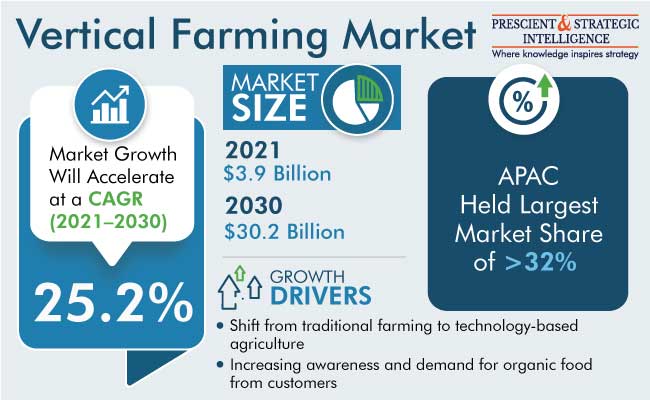How Does Shortage of Fertile Land Boost Requirement of Vertical Farming?
The worldwide vertical farming industry has garnered $3.98 billion revenue in 2021, and it is projected to generate $30.2 billion revenue in 2030, rising at a rate of 25.2%. It is ascribed to advantages of the vertical farming, including less consumption of power, water, and land requirements, that facilitates growers to reduce the processing and washing time of produced crops.
In addition, the shortage of agricultural land, and rising demand for organic food are major drivers of the industry. In addition, the advanced agriculture techniques provide support to growers to expand production by more than 230 times crop yields compared to conventional farming.
The cannabis industry is primarily adopting enhanced indoor agriculture to boost productivity. Moreover, the unexpected explosion of the worldwide urban population and the rising focus on the eco-friendly production of fresh fruits and vegetables fuel the application of indoor agriculture.
Furthermore, the rising demand and production of tomatoes have fuelled over the last years. In addition, the growing popularity of green salads fuels the demand for spinach worldwide. Vertical farming companies are producing various types of breeds to fuel production and cater to vegetable demand.
The hydroponics category holds the largest revenue share, at 45%, and it is projected to retain the same position in the coming years. It is ascribed to economic implementation and ease of operation. Hydroponically grown plants produce greater yields compared to soil-growing plants. Such methods provide support in reducing the risk of diseases caused by soil.
The aquaponics category is projected to capture the largest industry share in the near future. It is the combination of aquaculture or fish farming to develop an efficient closed-loop system, that propels the farming of various types of crops without impacting pesticides or harmful chemicals.
The lighting category captures the industry share, ascribing to growing consumer demands for organic foods. The lighting components consist of LED lights, grow light reflectors, pink lights, grow light ballasts, and various types of artificial cultivation lights that support vertical agriculture.
The shipping container leads the industry with more than 50% industry, and it is projected to experience the same trend in the coming future. The major advantages of container farming include easy transportation and less area requirement due to the whole process of crop production in a container.
Such types of cultivation offer more than eight times the growing area, compare to single-level agricultural land. Thus, such cultivation offers nearly eight times better growing area compare to single-level agricultural land, thus it determines food security for a longer period in the city.
APAC holds a significant share of the industry, with more than 32% in 2021. The Indian vertical farming industry is projected to rise rapidly in the coming years. Due to the insufficiency of fertile agricultural land and the growing population, vertical agriculture is massive adoption in the region.
Therefore, the shortage of agricultural land fuels the demand for vertical farming industry.
Read More: https://www.psmarketresearch.c....om/market-analysis/v
